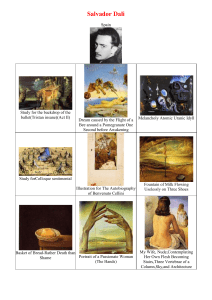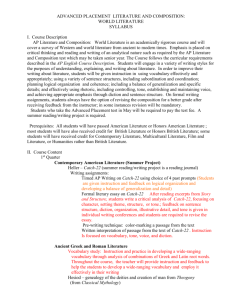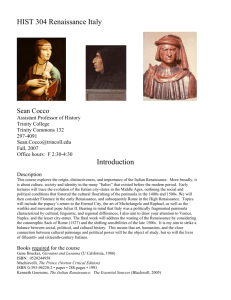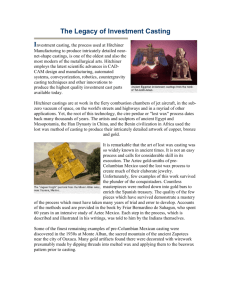7.3.2. Writing to the Times
advertisement
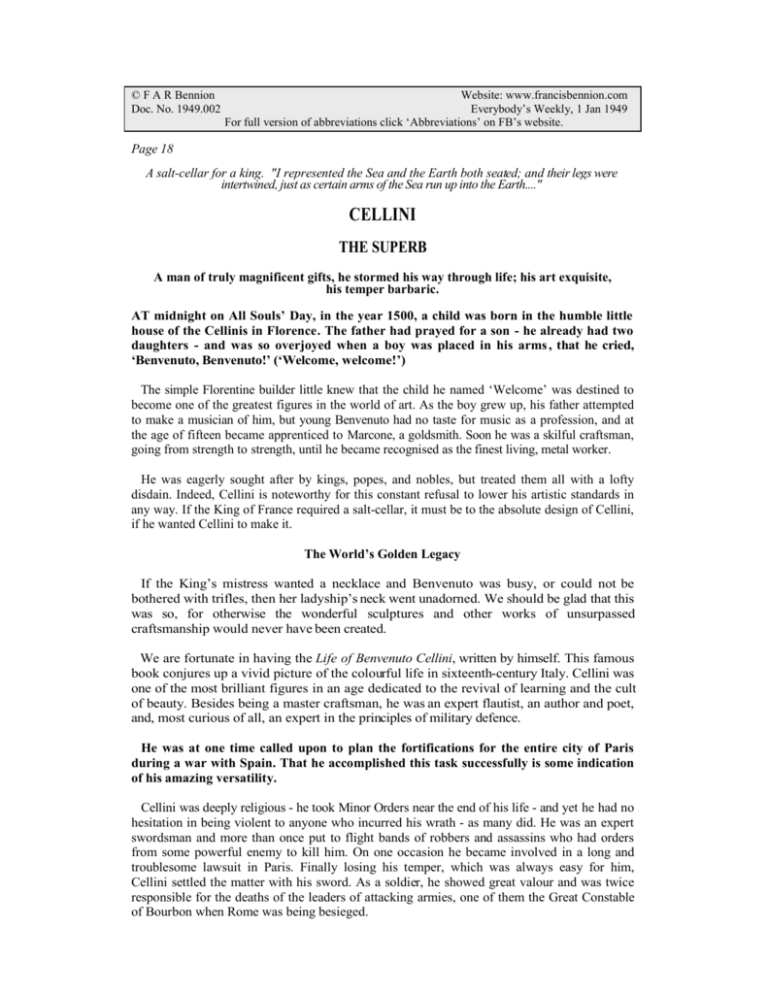
© F A R Bennion Doc. No. 1949.002 Website: www.francisbennion.com Everybody’s Weekly, 1 Jan 1949 For full version of abbreviations click ‘Abbreviations’ on FB’s website. Page 18 A salt-cellar for a king. "I represented the Sea and the Earth both seated; and their legs were intertwined, just as certain arms of the Sea run up into the Earth...." CELLINI THE SUPERB A man of truly magnificent gifts, he stormed his way through life; his art exquisite, his temper barbaric. AT midnight on All Souls’ Day, in the year 1500, a child was born in the humble little house of the Cellinis in Florence. The father had prayed for a son - he already had two daughters - and was so overjoyed when a boy was placed in his arms , that he cried, ‘Benvenuto, Benvenuto!’ (‘Welcome, welcome!’) The simple Florentine builder little knew that the child he named ‘Welcome’ was destined to become one of the greatest figures in the world of art. As the boy grew up, his father attempted to make a musician of him, but young Benvenuto had no taste for music as a profession, and at the age of fifteen became apprenticed to Marcone, a goldsmith. Soon he was a skilful craftsman, going from strength to strength, until he became recognised as the finest living, metal worker. He was eagerly sought after by kings, popes, and nobles, but treated them all with a lofty disdain. Indeed, Cellini is noteworthy for this constant refusal to lower his artistic standards in any way. If the King of France required a salt-cellar, it must be to the absolute design of Cellini, if he wanted Cellini to make it. The World’s Golden Legacy If the King’s mistress wanted a necklace and Benvenuto was busy, or could not be bothered with trifles, then her ladyship’s neck went unadorned. We should be glad that this was so, for otherwise the wonderful sculptures and other works of unsurpassed craftsmanship would never have been created. We are fortunate in having the Life of Benvenuto Cellini, written by himself. This famous book conjures up a vivid picture of the colourful life in sixteenth-century Italy. Cellini was one of the most brilliant figures in an age dedicated to the revival of learning and the cult of beauty. Besides being a master craftsman, he was an expert flautist, an author and poet, and, most curious of all, an expert in the principles of military defence. He was at one time called upon to plan the fortifications for the entire city of Paris during a war with Spain. That he accomplished this task successfully is some indication of his amazing versatility. Cellini was deeply religious - he took Minor Orders near the end of his life - and yet he had no hesitation in being violent to anyone who incurred his wrath - as many did. He was an expert swordsman and more than once put to flight bands of robbers and assassins who had orders from some powerful enemy to kill him. On one occasion he became involved in a long and troublesome lawsuit in Paris. Finally losing his temper, which was always easy for him, Cellini settled the matter with his sword. As a soldier, he showed great valour and was twice responsible for the deaths of the leaders of attacking armies, one of them the Great Constable of Bourbon when Rome was being besieged. Unlike most of the people he had to deal with, Cellini was honest. At any suggestion that he was not to be trusted, he would fly into a passion and, reckless of consequence, would tell the Cardinal or Prince just what he thought of him. Once he was falsely accused of stealing Church jewels at the time of the sack of Rome. On being questioned by the Governor and other officials, he told those august gentlemen that their words had no meaning and begged them ‘to stop their babblings and speak the truth’. As a result of this imprudence, he was imprisoned by the Pope in the Castle of S. Angelo. Escaped—Recaptured In his Memoirs, Cellini has left a remarkable account of his escape from this grim fortress. The keeper of the Castle suffered from delusions, and at the time of Cellini’s imprisonment imagined himself to be a bat. He therefore instructed the guards to let him fly after the prisoner if he escaped. Fortunately for him the deluded keeper was not told of Cellini’s escape until too late! The escape was effected largely owing to Cellini’s cunning in abstracting a pair of pliers from a tool chest when his gaoler’s back was turned. With these he drew out the nails which held the hinges of his cell door in place, putting candle grease mixed with rust into the holes thus made, so that the missing nails would not be noticed. When the time was ripe he tore his sheets into strips and, removing the now ineffective door, made his way to the battlements. He descended by means of the linen strips, but they were too short, and in the final fall he broke his leg and became unconscious. Character Of A Seer When he came to his senses he crawled along towards the city gate, eventually being taken into the Palace of a Cardinal. But then he was betrayed and forced to return to the Castle, being placed in the very deepest dungeon, ‘where there was a great quantity of water, full of tarantulas and other poisonous insects’. Happily Cellini had influential friends who secured his release some time later. There can be no doubt that, along with his other powers of mind, Benvenuto possessed the character of a Seer. During Page 19 his imprisonment in the dungeon of S. Angelo, he was (he tells us) frequently aware of the presence of a spiritual Being who consoled and strengthened him, and before his deliverance he was vouchsafed a vision of extraordinary beauty and grandeur, in which he seemed to be transported from his prison and to behold the sun ‘like a bath of the purest molten gold’. While beholding this wondrous thing, I noticed (he says), that the middle of the sphere began to swell, and the swollen surface grew, and suddenly a Christ upon the cross formed itself out of the same substance as the sun. The sculptor’s Memoirs contain a number of mystical experiences and a fascinating account of a Conjuration of spirits Salt-Cellar For A King Intensely interesting though the personal details of Cellini’s life are, it is for his artistic achievements that he is really important. Many of his works are lost to us, but enough remain after the passing of four centuries for us to appreciate his genius. Cellini was prolific in his output of jewellery: buckles, girdles, rings, medals, brooches, pendants and necklaces were executed for the pleasure and adornment of the. noble ladies of Florence, Rome and Paris; swords and daggers, exquisitely ornamented, for the lords and gallants; and magnificent examples of silver-work for use on the banqueting tables of the time. A particularly magnificent gold salt cellar was made for the King of France. The work is of incredible complexity and richness of design. Cellini describes it in these words: ‘I represented the Sea and the Earth, both seated; and their legs were intertwined just as certain arms of the Sea run up into the Earth, and the Earth juts out into the Sea. And in the right hand of the Sea a trident was placed, while the left hand held a boat, delicately chased, for the reception of the salt. . . . For the Earth I chose a very beauteous woman, with the Horn of Plenty in her right hand, while the left held a small temple in the Ionic style and in this I had arranged the pepper. Beneath this figure I placed the handsomest animals the earth produces. . . .’ His Finest Works Cellini goes on to say that when this marvel was placed before the eyes of the King, ‘he uttered an expression of astonishment and could not sufficiently gaze at it’. Needless to say no one nowadays takes his condiments from this salt-cellar. It is preserved in the Imperial Treasury of Vienna. The finest works of Cellini as a sculptor are the Ganymede, the Nymph of Fontainebleau, the Apollo and Hyacinth, the Narcissus and the Crucifix at Madrid. This wonderful image of Christ on the cross was carved by Cellini in white marble to prove his ability to execute statuary in stone as well as in bronze. Perseus is a colossal bronze, which today still stands on its original site in Florence. It is in this tremendous work that we see the full flowering of the great Florentine’s genius. The statue was completed in the face of difficulties and disasters which would have overwhelmed a lesser man. In the first place Cellini had to contend with the envy and malice of his rival, the sculptor Bandinelli, who was inferior in talent but had the ear of Cellini’s patron, Pope Clement. This nearly resulted in Cellini’s being deprived of the Papal grant, which was indispensable if he was to carry on. ‘Your Work Is Spoiled’ Having settled this difficulty, the sculptor nearly lost everything in a fire at his workshop. So violent were his exertions in extinguishing the blaze, that he had to take to his bed with a fever, leaving his workmen to carry on with the casting of the statue. During the night a man, ‘who in his appearance seemed to be as crooked as a capital S’ entered the sick man’s bed chamber and cried out in a mournful voice: ‘Oh Benvenuto! Your work is spoiled; and there is no help for it in this world’. At this Cellini leapt from his bed with a dreadful cry and began flinging his clothes on, aiming kicks and blows at all who approached him, weeping and shouting curses in his anguish. Rushing to the workshop he found the workmen standing about in doleful silence; haying allowed the furnace to go out and the metal to cool. His chief assistant came up to him and said that it was useless to go on - nothing could be done. The Metal Flowed Again The master was not beaten however. He rallied the workmen with a few impetuous words and set about to repair the damage, even using three hundred pieces of pewter from his own household to fill the mould. The scene in which the situation is saved and the metal set flowing again is one of the most dramatic in all literature. When the statue was finally completed and exhibited in the public square the populace ‘set up so loud a shout of applause that I began to be somewhat comforted for the mortifications I had undergone; and there were sonnets in my praise every day upon the gate, the language of which was extremely elegant and poetical’. Benvenuto Cellini died in 1571, being just over seventy. Before his death he was made a Florentine noble and was also received into Minor Holy Orders. Few men indeed can claim to have lived a life so full and varied as his. A Great Artist He was a brilliant son of a brilliant age, the age of the rebirth of that lofty conception of Art which the ancient Greeks had created, an age in which everywhere men of genius strove towards the beautiful and the sublime. Like his great master Michelangelo, Cellini stoutly maintained the integrity of his art. Nothing would induce him to descend to the cheap and vulgar methods of his many competitors. Aloof and yet human, he lives through the ages as a great artist and a magnificent personality. VENTER NICHOLL

